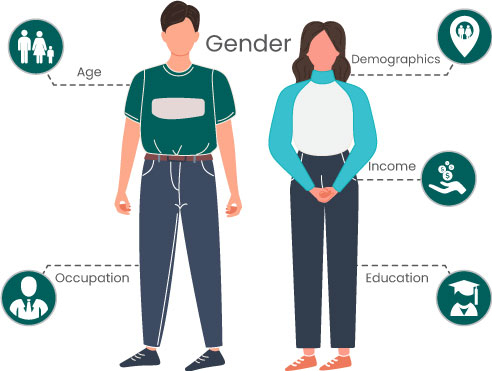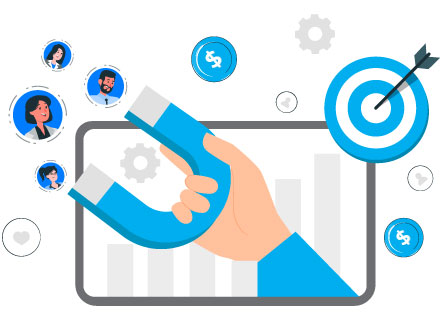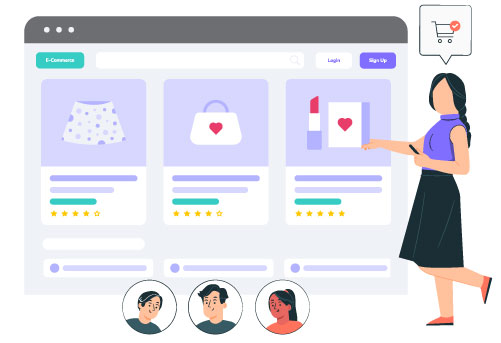How have you felt when you’ve received emails completely irrelevant to you?
A college-going, unmarried girl receiving a promotional message of the new range of baby products at an e-store, a man receiving messages about the earring collections available at an outlet and so many other such instances make you feel ridiculous about mass email marketing campaigns.
Brands and businesses send mass generic campaigns to their entire contact list due to time constraints.
The ideal solution to this is email segmentation. For, it helps you avoid irrelevant messaging and send only personalized content. That is the right message to the right people.
Read on to know what email segmentation is and the strategies to come up with the best-targeted email campaigns. Here we go.
Contents
What is email segmentation?

Email segmentation involves dividing your list of email contacts into different groups based on shared attributes. Marketers do this with the intention of sending tailored email campaigns to each segment.
Unlike market segmentation that segments your entire audience/consumers, email segmentation segments only your email subscribers.
Below-given are the four basic types of email segmentation:
- Demographic segmentation: This involves segmenting your contacts based on concrete information like age, sex, education, profession, income, marital status, family type, race, religion, etc.
- Psychographic segmentation: This involves segmenting your subscribers based on subjective attributes of their personalities. For instance, personality, attitudes, social status, interests, opinions, activities, and lifestyle.
- Behavioral segmentation: This involves segmenting your contacts based on their past interactions with your business. For example, browsing behavior, purchases, queries made, etc.
- Geographic segmentation: This involves segmenting your subscribers based on their geographic location. For instance, country, urban, rural, semi-urban, etc.
Why is Email Segmentation Important?
Businesses and their marketers prioritize email segmentation as it improves their marketing and increases their bottom line. Here are the several benefits ushered in by email segmentation.
- Improved deliverability: Email segmentation increases engagement and sender reputation. This prevents your future campaigns from being sent to spam.
- Stronger relationships: Email segmentation helps your brand connect with individual subscribers by consistently sending personalized content. And this results in repeat purchases and customer loyalty. Thus, email segmentation can serve as one of your best customer retention strategies.
- Higher Conversion Rate and ROI: Studies have proven that segmented email marketing campaigns bring in 100.95% increased click rates and a 760% increase in email revenue than non-segmented ones.
- Better campaign results: Since email segmentation increases the relevancy of your campaigns to the recipients, there are better responses and results.
- Increased knowledge of your audience: By segmenting your contacts and personalizing campaigns, you gain a better understanding of your customers. You get to know what works and what doesn’t with each group.
5 Email Segmentation Strategies to Create the Best Targeted Campaigns
1. Location

Segmenting your subscribers based on their countries, regions, or locations is crucial if your business operates in different geographic locations.
It’s even more important when you’re working in different time zones. For, it helps in preventing low open rates, confusions, and discontents.
For instance, if you’re running an e-commerce business with an international presence, sending time-limited offer messages in bulk will end up shortening the time for people on the other side of the globe, resulting in frustrations.
Geographic location-based segmentation can also be of help to those businesses that make weather-based, traffic-based, language-based, season-based, cultural preference-based, or current news-based recommendations.
For instance, McDonald’s promotes its chicken and veg rice-bowls only in India, where people’s staple food is rice.
2. Demographics

Segmenting email contacts based on demographic data such as age, gender, education level, income, etc. is the most common type of segmentation practiced by businesses. You can get this info while your customers sign up for receiving emails from you.
Getting as many details as possible about your customer would be helpful. However, asking too many details can scare them off from subscribing to you.
So, determine those demographic attributes that are most essential for your business before including those fields in the signup form.
For instance, if you’re a clothing brand, you’ll need to know their gender info; if you’re selling highly-priced goods, their income level would be of prime importance to you; if you’re a SaaS agency, their company position would aid you in your SaaS marketing; and so on.
3. Engagement level

Grouping your customers into different segments based on their level of engagement with your brand can help you personalize messages accordingly to increase conversions.
For this, you need to look into your email marketing’s performance metrics such as open rates and click-through rates. Based on these analytics, you can group your subscribers into two groups viz., active users and inactive users.
You can send personalized campaigns to the active group asking them to refer your brand in the circle in exchange for a discount or cash prize. For the inactive group, start targeting them with re-engagement/re-activation campaigns.
You can even combine additional data individually with your active and inactive user segments to reveal their true interests.
You can then develop marketing strategies to target them based on your interpretations. This in turn will improve your email marketing outcomes.
4. Purchase history

By looking into your customers’ purchase history, you’ll get to know their needs and preferences and their shopping habits. That is, you’ll get an idea about what they buy and how much they spend.
Therefore, segmenting customers based on their purchasing history helps you come up with campaigns that will motivate them to keep purchasing from you.
For instance, send discount coupons and combo offers to those customers who are the most price-sensitive and usually buy items on sale.
To customers who regularly purchase certain items (like cosmetics, cleaning items, etc.) send remainder emails after an appropriate time period. Sending relevant and timely emails this way can also increase conversion.
You can also use purchase history-based segmentation for sending cross-selling and up-selling campaigns.
Further, based on the average amount of money customers spend at your store, you can segregate your VIP customers and encourage more brand loyalty by giving them special discounts.
5. Association with you
Your customer or prospect’s duration of association with your brand is another attribute for segmenting your email subscribers for better marketing results. Here are four segments on this basis.
- New subscribers who haven’t yet purchased from you: It’s important you make a great first impression with your email marketing messages. So, run a campaign for this segment with a series of welcome emails. These should have inspirational content that introduces them to your brand and boost their interest in you.
- First-time customers: When a person buys from you for the first time, it means that he/she has started trusting you. Focus on building their trust through reviews, testimonials, and other user-generated content. Also, let them know more about your offerings and send them educational resources to help them make the most out of their purchase.
- Loyal customers: Studies say that customers who are loyal to a brand feel the need to be acknowledged by it. So, make regular, long-term customers feel special with VIP offers like special discounts, early access to new products, etc. You can also request a review from them or invite them to join your referral program and refer their friends to you.
- Inactive customers: Target those customers who’ve become silent for a while with retargeting campaigns. You can lure them back with a discount or offer on items of their interest. You can also come up with your own creative ideas to get their attention again.
Email Marketing Automation Tool Simplifies the Job for You
Segmenting your email contacts based on the above-discussed criteria isn’t a tough job. You just need a good email marketing automation software like NotifyVisitors. It has the capability to automatically segment your subscribers based on location, age, and almost any behaviour exhibited by them online.
Other than customer segmentation, it also has other attractive features like Gmail Extension (work out of Gmail), hassle-free migration services (bring in your email contacts from any platform that you’re using), effectual contact management, customizable automation goals, detailed data analytics of your campaigns, iOS CRM app (access contacts, send emails, update deals, and check tasks on the go!), and more.
Apart from email marketing, it also has tools for facilitating SMS marketing, customer relationship management, and marketing automation.
So, do make use of this useful software to get the best out of your email marketing! You can try it for free to decide whether or not you’ll find it useful. We’re sure you’ll love it!
Conclusion
Email segmentation helps your brand/business send only personalized content and avoid irrelevant messaging.
Since it facilitates delivering the right message to the right people, your conversion rates increase, email deliverability increases, returns on investment heightens, and customer relationships strengthen via a better understanding of your customers.
You can segment your email subscribers in several ways to tap into the immense potential of segmentation.
In this blog, we’ve discussed email segmentation strategies to help you come up with the best-targeted campaigns. Do use an email marketing automation tool like NotifyVisitors to help you achieve desirable results from applying these strategies.
Read more:
- 19 Best Email Segmentation Ideas to Boost Conversion
- How to Segment an Email List? Best Tips, Ideas and Strategies
- 31+ eCommerce Email Marketing Statistics to Know
- 19 Best eCommerce Email Marketing Software
- 23 Best Email Marketing Tools Compared

























 Email
Email SMS
SMS Whatsapp
Whatsapp Web Push
Web Push App Push
App Push Popups
Popups Channel A/B Testing
Channel A/B Testing  Control groups Analysis
Control groups Analysis Frequency Capping
Frequency Capping Funnel Analysis
Funnel Analysis Cohort Analysis
Cohort Analysis RFM Analysis
RFM Analysis Signup Forms
Signup Forms Surveys
Surveys NPS
NPS Landing pages personalization
Landing pages personalization  Website A/B Testing
Website A/B Testing  PWA/TWA
PWA/TWA Heatmaps
Heatmaps Session Recording
Session Recording Wix
Wix Shopify
Shopify Magento
Magento Woocommerce
Woocommerce eCommerce D2C
eCommerce D2C  Mutual Funds
Mutual Funds Insurance
Insurance Lending
Lending  Recipes
Recipes  Product Updates
Product Updates App Marketplace
App Marketplace Academy
Academy

